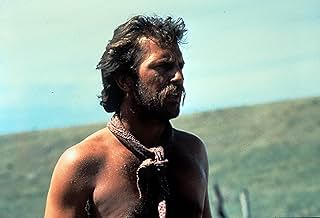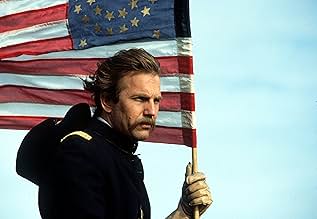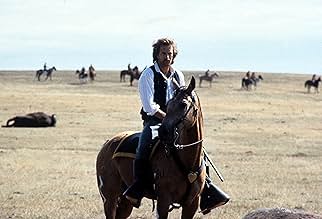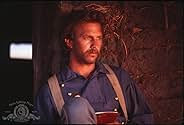Il tenente John Dumbar, assegnato ad un avamposto remoto durante la guerra civile, diventa amico di lupi ed indiani, inimicandosi i suoi superiori nell'esercito.Il tenente John Dumbar, assegnato ad un avamposto remoto durante la guerra civile, diventa amico di lupi ed indiani, inimicandosi i suoi superiori nell'esercito.Il tenente John Dumbar, assegnato ad un avamposto remoto durante la guerra civile, diventa amico di lupi ed indiani, inimicandosi i suoi superiori nell'esercito.
- Vincitore di 7 Oscar
- 55 vittorie e 39 candidature totali
Floyd 'Red Crow' Westerman
- Ten Bears
- (as Floyd Red Crow Westerman)
Best Picture Winners by Year
Best Picture Winners by Year
See the complete list of Best Picture winners. For fun, use the "sort order" function to rank by IMDb rating and other criteria.
Trama
Lo sapevi?
- QuizBecause of the film's enormous success and sympathetic treatment of the Native Americans, the Lakota Nation adopted Kevin Costner as an honorary member.
- BlooperElectric power lines are visible during the buffalo hunt.
- Citazioni
Wind In His Hair: [in Lakota; subtitled] Dances with Wolves! I am Wind In His Hair. Do you see that I am your friend? Can you see that you will always be my friend?
- Versioni alternativeThe 236-minute "extended version" or "Director's Cut" has been released on home video, altering the movie as such:
- 38 x new scene
- 15 x extended scene
- 12 x alternative footage
- 5 x alternative text
- 1 x new text
- 3 x postponed scene
- 3 x altered arrangement of scenes
- 3 x shortened scene.
- Colonne sonoreFire Dance
By Peter Buffett
Recensione in evidenza
I haven't seen "Dances With Wolves" for years but recently rediscovered its brilliance. Released in 1990, the story involves Lt. Dunbar (Kevin Costner), a Civil War hero, singlehandedly manning a desolate prairie post in South Dakota. He becomes intrigued by his Native American neighbors, a small tribe of Lakota Sioux, and slowly develops good relations with them. He ultimately adopts a Sioux name - Dances With Wolves - and assimilates with the tribe. When the U.S. Army discovers his actions he is treated as a treasonous deserter. Mary McDonnell and Graham Greene have key roles.
This is, simply put, filmmaking of the highest order. Everything magically works in this absolutely engaging 3-hour epic Western. The extended director's cut is an hour longer and most of the added material is worthwhile and fleshes out the characters more than the theatrical cut. I recommend watching the 3-hour version and, if you want more, check out the expanded version.
Over the years I've heard some grumbling about the film's PC-influenced negative portrayal of whites in general and also its supposed romanticized portrayal of Indians as super-virtuous. Hence, before viewing the film again I was braced for the worst. After seeing it, I must say that most of these grumblings are hogwash. No kidding. Really, only a rigid white redneck "patriot" would take offense to this story (and, don't get me wrong, I'm patriotic but not mindlessly so). The film rings of authenticity and the characters are anything but one-dimensional. Want proof? (No major spoilers).
This is just a taste. Clearly, the people in the film are not as one-dimensional as some maintain. Neither is the movie as pro-Indian/anti-white as some insist. It's more complicated than that.
As to the accuracy of the story itself, the fact is that many whites have "gone injun" and many Natives have assimilated with whites. The story explores the possibility of what would happen if a white man dropped all prejudices and tried to get along with some Sioux neighbors; and what if this small band of Natives was open and curious enough to accept him? Is it unlikely that this band would have an available good-looking white woman amongst them that Dunbar could fall in love with? Is there a bit of romanticization? Yes, but it IS a Hollywood movie, after all. Regardless, it's presented in a believable, compelling and captivating way.
"Dances" is almost 20 years old but remains timeless like most great films; it is the definition of why films are made.
The film was shot mostly in Western South Dakota with additional shooting in Jackson, Wyoming, as well as Nebraska and Kansas.
GRADE: A+
This is, simply put, filmmaking of the highest order. Everything magically works in this absolutely engaging 3-hour epic Western. The extended director's cut is an hour longer and most of the added material is worthwhile and fleshes out the characters more than the theatrical cut. I recommend watching the 3-hour version and, if you want more, check out the expanded version.
Over the years I've heard some grumbling about the film's PC-influenced negative portrayal of whites in general and also its supposed romanticized portrayal of Indians as super-virtuous. Hence, before viewing the film again I was braced for the worst. After seeing it, I must say that most of these grumblings are hogwash. No kidding. Really, only a rigid white redneck "patriot" would take offense to this story (and, don't get me wrong, I'm patriotic but not mindlessly so). The film rings of authenticity and the characters are anything but one-dimensional. Want proof? (No major spoilers).
- The Pawnee are the first Indians the viewer encounters in the film and they are portrayed as completely hostile to whites and other NA tribes - so hostile that they'll kill a white person on sight without mercy. I'd say this is a negative, stereotypical portrayal of Indians, wouldn't you agree?
- Also, Wind In His Hair (Rodney A. Grant) clearly states that the Sioux should kill Dunbar at the council meeting; I'm sure there were others who agreed with him but it was ultimately decided that killing Dunbar would likely cause more problems than solve.
- Not all white people are shown in a negative light; in fact, Dunbar himself - the film's protagonist - is white. What about the "foul" guy, Timmons, who escorts Dunbar to the abandoned fort? I've met people just like him. He's not portrayed as evil, but merely uncouth in dress and manners. Anyway, when Timmons gets savagely murdered by a band of Pawnee he begs over and over that the Indians not hurt his mules; his dying words are words of love (for his animals!). Also, when he says goodbye to Dunbar at the fort he says, "Good luck, Lieutenant" and you know he means it; the words show love and respect. Obviously this was a disgusting guy with a heart of gold. Again I know people just like him; it rings of authenticity.
- The story takes place during the Indian Wars where there's very little love & compassion of whites towards Indians and vice versa. The U.S. Army is there to do a job and, as usual, go by the book. Is this a negative portrayal or simply the way it was? The answer is obvious. Hence, most of the officers are not shown in a negative light but merely as military leaders carrying out their duty. Although some of the main enlisted soldiers come off as clueless sheetheads, again, the characters ring of true life. I met people just like 'em in the military.
- Besides, I repeat, not all Natives are depicted as virtuous. The Pawnee are obviously ruthless villains and quite a few Indians are shown helping the U.S. Army and are, therefore, traitors to their people.
- Is the small tribe of Lakota Sioux really super-virtuous? Is their lifestyle really a paradise? No, they're merely portrayed as real people living, pursuing happiness, uncertain about the amassing whites, fighting and persevering through hardships (like the winter camp).
- Is the massive annihilation of Bison (leaving their skinless carcasses to rot in the sun) a negative depiction of whites or just the way it was? Such people would likely shoot a wolf for the "fun" of it. Again, it smacks of reality.
This is just a taste. Clearly, the people in the film are not as one-dimensional as some maintain. Neither is the movie as pro-Indian/anti-white as some insist. It's more complicated than that.
As to the accuracy of the story itself, the fact is that many whites have "gone injun" and many Natives have assimilated with whites. The story explores the possibility of what would happen if a white man dropped all prejudices and tried to get along with some Sioux neighbors; and what if this small band of Natives was open and curious enough to accept him? Is it unlikely that this band would have an available good-looking white woman amongst them that Dunbar could fall in love with? Is there a bit of romanticization? Yes, but it IS a Hollywood movie, after all. Regardless, it's presented in a believable, compelling and captivating way.
"Dances" is almost 20 years old but remains timeless like most great films; it is the definition of why films are made.
The film was shot mostly in Western South Dakota with additional shooting in Jackson, Wyoming, as well as Nebraska and Kansas.
GRADE: A+
I più visti
Accedi per valutare e creare un elenco di titoli salvati per ottenere consigli personalizzati
Dettagli
- Data di uscita
- Paesi di origine
- Siti ufficiali
- Lingue
- Celebre anche come
- Danza con lobos
- Luoghi delle riprese
- Badlands National Park, South Dakota, Stati Uniti(Fort Hays to Fort Sedgewick Wagon journey)
- Aziende produttrici
- Vedi altri crediti dell’azienda su IMDbPro
Botteghino
- Budget
- 22.000.000 USD (previsto)
- Lordo Stati Uniti e Canada
- 184.208.848 USD
- Fine settimana di apertura Stati Uniti e Canada
- 598.257 USD
- 11 nov 1990
- Lordo in tutto il mondo
- 424.208.848 USD
- Tempo di esecuzione3 ore 1 minuto
- Colore
- Proporzioni
- 2.39 : 1
Contribuisci a questa pagina
Suggerisci una modifica o aggiungi i contenuti mancanti




































